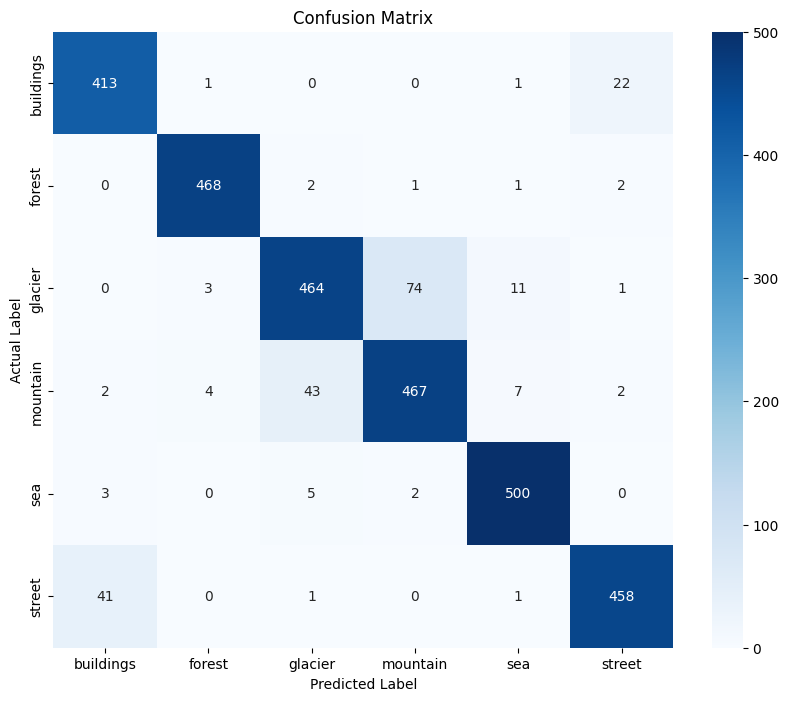Nature Scene Classification Using Transfer Learning with Inception V3 on the Intel Scene Dataset
Keywords:
Nature Scene, Xception Model, Inception-V3 Model, Transfer LearningAbstract
Nature scene classification is vital for various applications, including environmental monitoring and autonomous systems need to develop efficient models that can sort out different scenes. This work proposes a new approach using state-of-the-art CNNs like InceptionV3, Xception and VGG19, to enhance the classification accuracy and generalization of nature scenes. We worked with six classes with 20,926 training images and 5,228 validation images and augmented the data to improve the model. Models were fine-tuned from the pre-trained models of ImageNet and early stopping and model checkpoints were used to avoid overfitting. The results indicated that the proposed InceptionV3 model achieved a training accuracy of 94.49% and validation accuracy of 92.81% which is higher than previous work and Xception model had a high accuracy of 95.52% but the model might be overfitting. During the comparison of the results, it was revealed that InceptionV3 provided the highest accuracy with the least standard deviation, which proved the effectiveness of the selected architecture for scene classification. These results indicate that the selection of the model and the technique for the classification of nature scenes is important. It is a good advancement in the field of nature scene classification and provides a reliable solution to enhance accuracy in real-world scenarios.
References
Z. Dong, M. Wang, Y. Wang, Y. Zhu, and Z. Zhang, “Object Detection in High Resolution Remote Sensing Imagery Based on Convolutional Neural Networks with Suitable Object Scale Features,” IEEE Trans. Geosci. Remote Sens., vol. 58, no. 3, pp. 2104–2114, Mar. 2020, doi: 10.1109/TGRS.2019.2953119.
F. Bastani et al., “RoadTracer: Automatic Extraction of Road Networks from Aerial Images,” Proc. IEEE Comput. Soc. Conf. Comput. Vis. Pattern Recognit., pp. 4720–4728, Dec. 2018, doi: 10.1109/CVPR.2018.00496.
S. D. Khan, L. Alarabi, and S. Basalamah, “Deep Hybrid Network for Land Cover Semantic Segmentation in High-Spatial Resolution Satellite Images,” Inf. 2021, Vol. 12, Page 230, vol. 12, no. 6, p. 230, May 2021, doi: 10.3390/INFO12060230.
S. Talukdar et al., “Land-Use Land-Cover Classification by Machine Learning Classifiers for Satellite Observations—A Review,” Remote Sens. 2020, Vol. 12, Page 1135, vol. 12, no. 7, p. 1135, Apr. 2020, doi: 10.3390/RS12071135.
S. D. Khan, L. Alarabi, and S. Basalamah, “An Encoder–Decoder Deep Learning Framework for Building Footprints Extraction from Aerial Imagery,” Arab. J. Sci. Eng., vol. 48, no. 2, pp. 1273–1284, Feb. 2023, doi: 10.1007/S13369-022-06768-8/METRICS.
M. T. Chiu et al., “Agriculture-vision: A large aerial image database for agricultural pattern analysis,” Proc. IEEE Comput. Soc. Conf. Comput. Vis. Pattern Recognit., pp. 2825–2835, 2020, doi: 10.1109/CVPR42600.2020.00290.
S. D. Khan, L. Alarabi, and S. Basalamah, “A Unified Deep Learning Framework of Multi-scale Detectors for Geo-spatial Object Detection in High-Resolution Satellite Images,” Arab. J. Sci. Eng., vol. 47, no. 8, pp. 9489–9504, Aug. 2022, doi: 10.1007/S13369-021-06288-X/METRICS.
L. Lin, L. Di, C. Zhang, L. Guo, and Y. Di, “Remote Sensing of Urban Poverty and Gentrification,” Remote Sens. 2021, Vol. 13, Page 4022, vol. 13, no. 20, p. 4022, Oct. 2021, doi: 10.3390/RS13204022.
A. Kazemzadeh-Zow, A. Darvishi Boloorani, N. N. Samany, A. Toomanian, and A. Pourahmad, “Spatiotemporal modelling of urban quality of life (UQoL) using satellite images and GIS,” Int. J. Remote Sens., vol. 39, no. 19, pp. 6095–6116, Oct. 2018, doi: 10.1080/01431161.2018.1447160.
M. A. A. Hoque, S. Phinn, C. Roelfsema, and I. Childs, “Tropical cyclone disaster management using remote sensing and spatial analysis: A review,” Int. J. Disaster Risk Reduct., vol. 22, pp. 345–354, Jun. 2017, doi: 10.1016/J.IJDRR.2017.02.008.
B. Zhao, Q. Dai, L. Zhuo, S. Zhu, Q. Shen, and D. Han, “Assessing the potential of different satellite soil moisture products in landslide hazard assessment,” Remote Sens. Environ., vol. 264, p. 112583, Oct. 2021, doi: 10.1016/J.RSE.2021.112583.
N. J. Murray et al., “The role of satellite remote sensing in structured ecosystem risk assessments,” Sci. Total Environ., vol. 619–620, pp. 249–257, Apr. 2018, doi: 10.1016/J.SCITOTENV.2017.11.034.
S. Mahato and S. Pal, “Groundwater Potential Mapping in a Rural River Basin by Union (OR) and Intersection (AND) of Four Multi-criteria Decision-Making Models,” Nat. Resour. Res., vol. 28, no. 2, pp. 523–545, Apr. 2019, doi: 10.1007/S11053-018-9404-5/METRICS.
P. L. Raeva, J. Šedina, and A. Dlesk, “Monitoring of crop fields using multispectral and thermal imagery from UAV,” Eur. J. Remote Sens., vol. 52, no. sup1, pp. 192–201, Mar. 2019, doi: 10.1080/22797254.2018.1527661.
B. Petrovska, T. Atanasova-Pacemska, R. Corizzo, P. Mignone, P. Lameski, and E. Zdravevski, “Aerial Scene Classification through Fine-Tuning with Adaptive Learning Rates and Label Smoothing,” Appl. Sci. 2020, Vol. 10, Page 5792, vol. 10, no. 17, p. 5792, Aug. 2020, doi: 10.3390/APP10175792.
F. Chollet, “Xception: Deep learning with depthwise separable convolutions,” Proc. - 30th IEEE Conf. Comput. Vis. Pattern Recognition, CVPR 2017, vol. 2017-January, pp. 1800–1807, Nov. 2017, doi: 10.1109/CVPR.2017.195.
M. Soudy, Y. Afify, and N. Badr, “RepConv: A novel architecture for image scene classification on Intel scenes dataset,” Int. J. Intell. Comput. Inf. Sci., vol. 22, no. 2, pp. 63–73, May 2022, doi: 10.21608/IJICIS.2022.118834.1163.
X. Wu, R. Liu, H. Yang, and Z. Chen, “An Xception Based Convolutional Neural Network for Scene Image Classification with Transfer Learning,” Proc. - 2020 2nd Int. Conf. Inf. Technol. Comput. Appl. ITCA 2020, pp. 262–267, Dec. 2020, doi: 10.1109/ITCA52113.2020.00063.
“Intel Image Classification.” Accessed: Oct. 01, 2024. [Online]. Available: https://www.kaggle.com/datasets/puneet6060/intel-image-classification

Downloads
Published
How to Cite
Issue
Section
License
Copyright (c) 2024 50SEA

This work is licensed under a Creative Commons Attribution 4.0 International License.




















